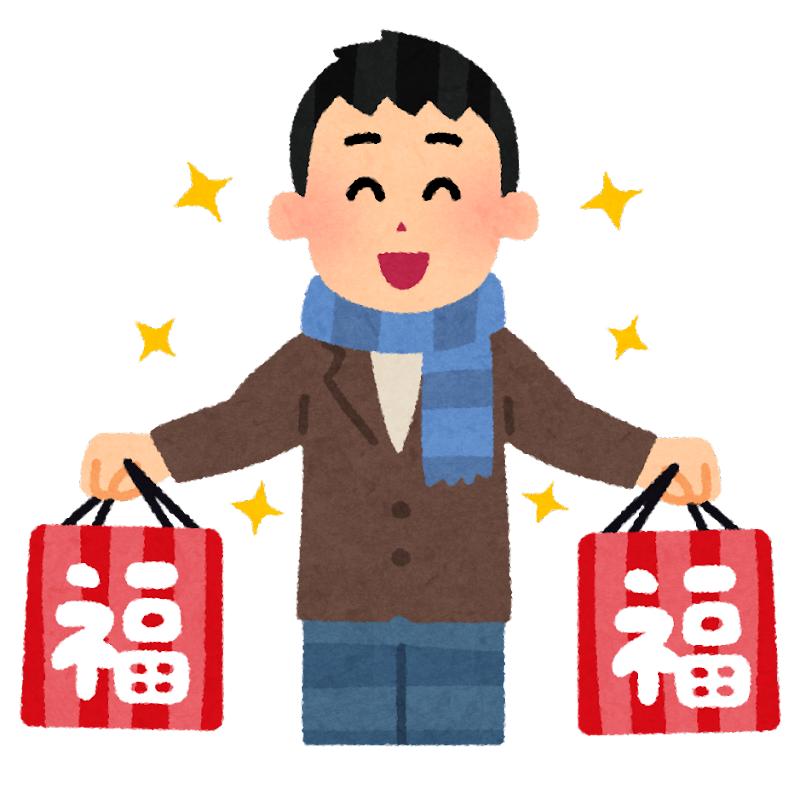Addressing challenges of clothes shopping in Japan
This article originally appeared in the December 2023 issue of CONNECT.
Holly Walder (Gunma)
Key Findings
- 78.3% say they experience sizing issues in Japan because the clothes are “too small”
- Half of respondents say it is difficult to find clothing in their preferred style
- Many respondents highlighted thrift stores such as Hard-Off and 2nd Street as their go-to, with Shimamura shining through a great budget-friendly plus-size option
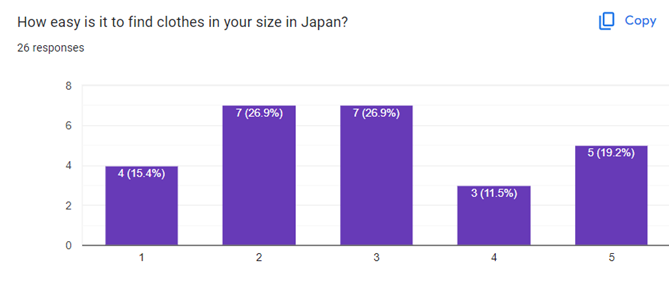
When creating this survey, I set out to pool together the knowledge and experience of the international community to help each other find clothes we want to wear. There were 26 respondents. There were 19 women, five men, and two non-binary people, 24 of whom were between 20 and 39 years old. The overwhelming majority of respondents were white—80%, and do not have any religious considerations when shopping for clothes. In addition, though this was not asked in the demographic portion of the survey, I observed in many of the answers that affordability was a priority when shopping for clothes, so most of the following brands mentioned have been chosen with that in mind.
Almost 70% of respondents found it was not too difficult to find clothing in their size. While one respondent expressed that it is easier to find affordable clothing in their size and style in Japan compared to the U.S., it was clear that many respondents have experienced sizing issues in Japan. Over 88% of respondents found that clothing runs too small and too short. In particular, respondents found that trousers present a particular issue. They found that Japanese trousers are unsuitable for curvy figures, especially if there is a large difference between the measurement of the waist and hips. There were various suggestions about what to do to solve this problem; primarily buying in your home country or ordering online, but tailoring menswear, choosing to wear more dresses, and learning to sew your own clothes were also given as other options. Bras also presented a significant problem for anyone with a large bust size.
Moreover, despite the majority of respondents saying that they wear mainly casual or classic clothing—styles that should be very easy to find—respondents found that the clothing they like is not in their size, not affordable, or too difficult to find. The average height of people in Japan is generally a few inches shorter than the average in countries with a majority white population, and the average weight is also significantly lower (1), so these results won’t come as a surprise to many people. Having said that, everyone needs clothes that fit them, and everyone deserves clothes that they like to wear. So below I have listed some suggestions and tips for finding fashion in Japan!
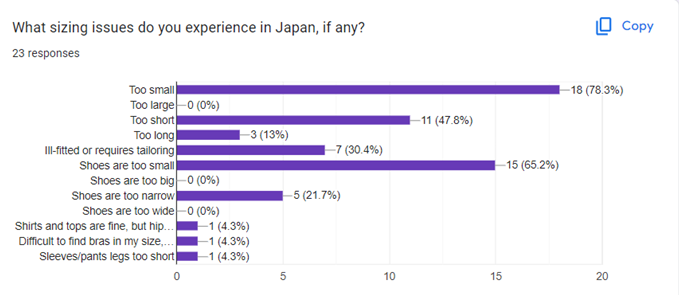
Where to Find that Fashion!
- Hard-Off, 2nd Street, and other thrift stores. Foreigners going home often donate their unwanted clothing to second hand stores when they leave, so it is easier to find things in your size there. Plus, it’s sustainable and affordable!
- Mercari also offers second-hand options online
- Shimamura is a good budget-friendly option of plus-sized clothing
- PUNYUS is a more streetwear style option
- Uniqlo offers a wide range of affordable basics in a wide range of sizes and offers some tailoring online (although the tailoring is still unsuitable for a curvier body type in my experience)
- Alinoma.jp and Smileland also offer affordable online clothing options
- Isetan offers mid to high-end clothing, an online ‘tall size’ for women up to 175 cm tall, and plus size shops
- International brands like H&M Japan, Amazon Japan, Gap, M&S Online, Next, Costco, Big and Tall, and Old Navy tend to have larger sizes. Zara is also good if you size up
- Crew is another international brand with a Japanese store and shipping to Japan, with both tall and plus size options for men and women, and shoes up to 28 cm, but the import fees can be expensive on some shoes
- Rui Glamorous offers larger bra sizes than most Japanese stores
- ACDC Rag uses mainly free-size, but the oversized shirts are a decent option if you’d like a more alternative style. 6%DokiDoki also offers a few colourful, plus-size options
- Eur3 offers casual and office wear in sizes up to 6L and shoes up to 25 cm at an affordable price
- Nissen offers the widest range I have seen so far with affordable prices. Nissen offers sizes up to 10L, some special sizes for women taller than 170 cm or shorter than 150 cm, and shoes up from 19 cm to 29 cm. However, the website is only in Japanese.
- LLQueen is also in Japanese and a bit difficult to order from, but they focus specifically on plus-size clothing
- Sakazen offer plus-size menswear online, and in stores up to size 10L
- q’s plus is the women’s range offered by Sakazen for women LL to 6L with 90 cm waists and shoes above 25 cm
- Aoki offers both tall and plus-size suits for men’s formal wear, and a more limited selection for women up to size 3L
- You can also find a wide range of sizes in Aeon
- MIDInternational offers menswear up to 8L
- Isetan’s “Super men’s” department store has mid to high-end clothing for men over 190 cm with waists above 90 cm
- If you’re in Tokyo, Comme ca Shinjuku offers European sizing for curvier figures, but runs a bit pricey
- Ito Yokado’s online store offers many plus size fashion options
- Plus-sized Japanese models are also a great source for information on where to buy clothing. Personally, I like Ai Momoka’s colourful style, but there are quite a few models and Instagram stars you can check out!
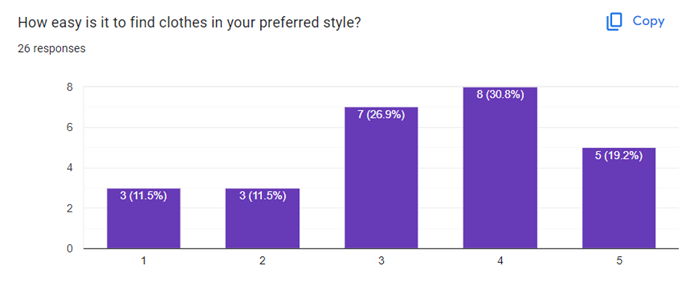
I will take this moment to acknowledge that there are a number of gaps in this article. This is not an exhaustive nor perfect list. We have yet to touch upon the issue of activewear, and though many of these brands are affordable, there is a paucity in good quality, comfortable, sustainable materials. Furthermore, the sample size for the survey was small and limited in demographic. There is no assumption that this represents the experience of fashion in the international community as a whole. It is most likely that it simply demonstrates who is most active in the places the survey was advertised (mainly through Facebook groups for foreigners in Japan and similarly focused Discord channels), and who is perhaps most frustrated about the struggles of finding clothes in Japan. However, I hope that this article might be of some assistance, and spur readers to come forward with more ideas, suggestions, and struggles that they have faced in Japan and keep this conversation going.
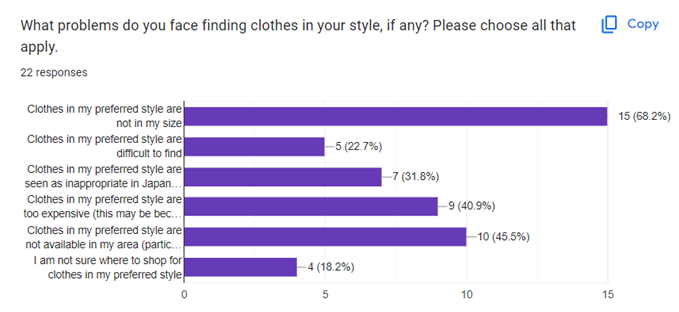
Holly Walder is a second-year ALT in Gunma Prefecture, and the Fashion Editor of CONNECT. She is on the hunt for a good pair of casual shoes.




